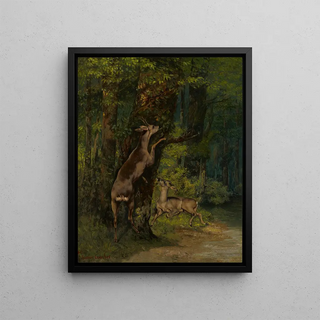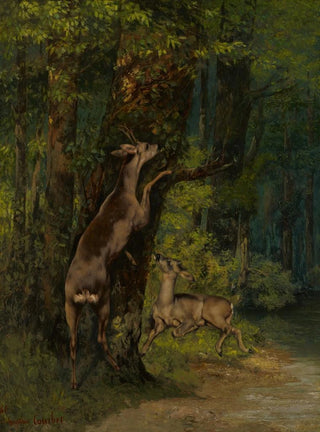Art print | Deer in the forest - Gustave Courbet


View from behind

Frame (optional)
Gustave Courbet's "Deer in the Forest" is an invitation to delve into the depths of wild and majestic nature. This artwork, which evokes the encounter between man and wildlife, stands out for its ability to capture a moment of tranquility in the heart of the forest. Through this depiction, Courbet manages to express a harmony between the animal and its environment, while revealing the raw and authentic beauty of the natural world. The scene, imbued with realism, transports us to a universe where the deer, a symbol of nobility and freedom, stands proudly amidst the trees, creating a silent dialogue between the artist and the viewer.
Style and uniqueness of the artwork
Courbet's style in "Deer in the Forest" is characterized by striking realism, typical of his work. The use of earthy colors and shades of green helps create an atmosphere that is both soothing and lively. The meticulous details, from the leaves to the light reflections on the deer's coat, demonstrate the artist's technical mastery. Every brushstroke seems to tell a story, where nature comes alive before the viewer's eyes. This painting does not merely depict a deer; it invites deeper contemplation, prompting reflection on the relationship between man and nature. By choosing to paint this animal in its natural habitat, Courbet reminds us of the importance of preserving this wild beauty, while celebrating the magnificence of wildlife.
The artist and his influence
Gustave Courbet, an emblematic figure of 19th-century realism, made his mark through his artistic and social commitment. His innovative approach to painting paved the way for many artists, who saw in him a model of authenticity and truth. Courbet did not merely reproduce the world as it was, but sought to reveal its deepest and sometimes darkest aspects. His influence extends beyond his time, inspiring artistic movements such as Impressionism and Symbolism. By painting "Deer in the Forest," Courbet does not limit himself to a simple representation; he engages

Matte finish

View from behind

Frame (optional)
Gustave Courbet's "Deer in the Forest" is an invitation to delve into the depths of wild and majestic nature. This artwork, which evokes the encounter between man and wildlife, stands out for its ability to capture a moment of tranquility in the heart of the forest. Through this depiction, Courbet manages to express a harmony between the animal and its environment, while revealing the raw and authentic beauty of the natural world. The scene, imbued with realism, transports us to a universe where the deer, a symbol of nobility and freedom, stands proudly amidst the trees, creating a silent dialogue between the artist and the viewer.
Style and uniqueness of the artwork
Courbet's style in "Deer in the Forest" is characterized by striking realism, typical of his work. The use of earthy colors and shades of green helps create an atmosphere that is both soothing and lively. The meticulous details, from the leaves to the light reflections on the deer's coat, demonstrate the artist's technical mastery. Every brushstroke seems to tell a story, where nature comes alive before the viewer's eyes. This painting does not merely depict a deer; it invites deeper contemplation, prompting reflection on the relationship between man and nature. By choosing to paint this animal in its natural habitat, Courbet reminds us of the importance of preserving this wild beauty, while celebrating the magnificence of wildlife.
The artist and his influence
Gustave Courbet, an emblematic figure of 19th-century realism, made his mark through his artistic and social commitment. His innovative approach to painting paved the way for many artists, who saw in him a model of authenticity and truth. Courbet did not merely reproduce the world as it was, but sought to reveal its deepest and sometimes darkest aspects. His influence extends beyond his time, inspiring artistic movements such as Impressionism and Symbolism. By painting "Deer in the Forest," Courbet does not limit himself to a simple representation; he engages






